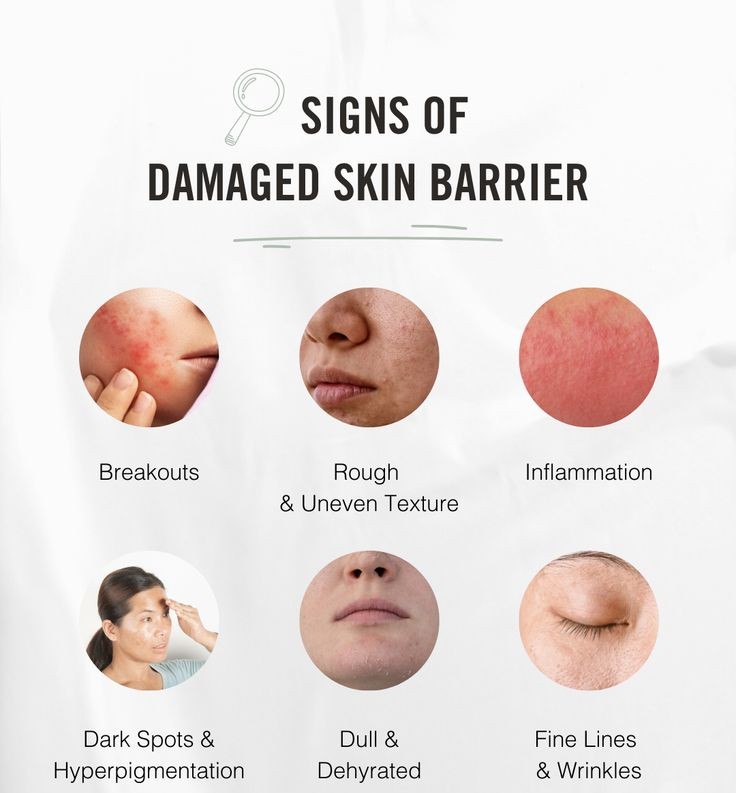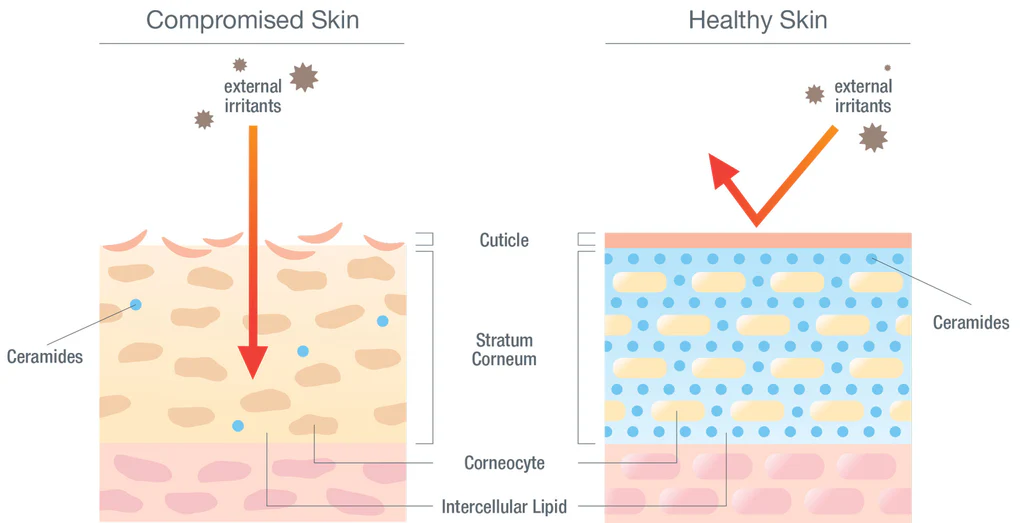Skin Barrier Repair 101: Signs, Causes & Natural Healing

Skin Barrier Repair: What is the Skin Barrier?
Fixing the skin barrier begins by knowing what the skin barrier is. The skin barrier, or stratum corneum, is the outermost part of your epidermis. It’s a layer of tightly bound dead skin cells (corneocytes) inextricably intertwined with needed lipids such as ceramides, cholesterol, and fatty acids—forming a “brick-and-mortar” complex. The barrier keeps your skin safe from outside aggressors while trapping moisture in.
Key Functions of the Skin Barrier:
1.Shields from External Damage:
The skin barrier is your skin’s initial defense against viruses, bacteria, toxins, allergens, and the sun.
2.Prevents Water Loss:
A good barrier keeps moisture in, stopping dryness and ensuring soft, moist skin.
3.Retains pH Balance:
It helps in maintaining the skin pH that is slightly acidic, important in the avoidance of pathogenic microorganisms.
4.Supports Immune Protection:
The barrier of the skin assists in stimulating skin cells which resist irritants and infections.
Why Skin Barrier Repair is Important?
When the natural defensive barrier of the skin is damaged—either by harsh skincare products, environmental stress, or skin disease—it performs less well. This creates moisture loss and makes it easier for irritants and bacteria to penetrate, leading to dryness, sensitivity, redness, and breakouts. Successful skin barrier repair is necessary to restore the protective barrier, enhance hydration, and mollify inflammation. Enhancing the barrier enables your skin to regain its shine and resilience naturally.
Signs of a Damaged Skin Barrier

Identifying the signs of a damaged skin barrier is most important to the application of successful skin barrier repair and restoring your skin’s health. After your skin barrier has been broken, it is no longer able to protect you from environmental invaders as well as hold moisture, resulting in many unpleasant and obvious symptoms.
Common Signs Are:
1.Dryness and Flaking:
Impaired skin barriers lose their ability to hold in moisture, building up dry, flaky patches. This is typically felt as tightness or roughness, especially after cleansing.
2.Redness and Irritation:
Impairment of the barrier function exposes your skin to irritants and allergens, leading to chronic redness, inflammation, or skin patching.
3.Increased Sensitivity:
Your skin may suddenly break out against products that it had previously tolerated with no issues. Even water or gentle cleansers may burn and sting.
4.Scratching and Blistering:
A weakened barrier frequently results in embarrassing itching or burning sensation as the protective role of the skin diminishes.
5.Breakouts and Blemishes:
When the barrier is damaged, bacteria and pollutants can penetrate deeper, triggering inflammation and acne-like breakouts.
6.Dullness and Uneven Texture:
Loss of hydration and protection can cause your skin to look tired, rough, and uneven in tone or texture.
Common Causes of Skin Barrier Damage:
Your skin barrier is your body’s first line of defense against water loss, irritants, and environmental stress. When your skin barrier is compromised, you’ll notice dryness, sensitivity, breakouts, or redness. To effectively repair your skin barrier, first know why damage occurs.
1. Environmental Stressors
Daily exposure to the impairment of the protective barrier of the skin, including:
-Toxicity (smoke, pollution, smog) causing inflammation and oxidative stress
-UV radiation that breaks down skin proteins and lipids
-Extreme weather conditions like cold, dry weather or over-heat that will dry up natural oils
2. Harsh or Overused Skincare Products
Some products and use habits can compromise the skin barrier, including:
-Over-exfoliation using physical scrubs or strong chemical exfoliants
-Strong chemicals containing sulfates or alcohol to remove oils
-Irritants including fragrances, dyes, and preservatives which may cause irritation, especially sensitive skin
3. Harmful Daily Habits
Routine everyday use inducing wear and tear on barriers:
-Long, hot showers that remove essential skin oils
-Excessive or aggressive washing of the skin
-With rough materials or abrasive cleaners that irritate the skin Poor sleep and chronic stress, which compromise the skin’s inherent repair mechanisms.
Effects of a Compromised Skin Barrier on Skin Health

When your skin barrier stays intact, it holds in moisture, excludes irritants, and has a healthy-looking appearance. But when it is damaged, your skin is open to all sorts of issues — some reversible, some irreversible. Being aware of these effects is important for understanding the value of early skin barrier repair.
1. Excess Water Loss (Transepidermal Water Loss)
A damaged barrier is unable to hold moisture effectively, resulting in:
-Dryness and flakiness
-Dry or thick skin texture
-Dehydration despite the use of moisturizers
This ongoing loss of water can cause the skin to look dry and feel taut.
2. Irritation and Sensitivity
Without a cover, the skin responds more readily to:
-Cosmetic preparations (even weak ones)
-Temperature variations
-Pollution and allergens
You may feel burning, stinging, or redness — all signs your skin is sensitive and inflamed.
3. Breakouts and Acne
A compromised barrier allows bacteria and soil to enter deeper. This can lead to:
-Recurrent breakouts or clogged pores
-Red, inflamed pimples
-Longer healing time for marks
Effective restoration of the skin barrier brings balance and reduces environmental-induced acne breakouts.
4. Redness and Inflammation
Chronic flush and inflamed lesions are normal when your defenses are down. Conditions include:
-Eczema
-Rosacea
-Dermatitis
can be increased or become more frequent because of barrier dysfunction.
5. Premature Aging
A compromised skin barrier is more prone to oxidative damage and collagen degradation, which can accelerate:
-Fine lines and wrinkles
-Loss of elasticity
-Irregular skin color
Long-term damage to the barriers enhances the vulnerability of the skin to environmental exposure-induced aging.
Natural Ways to Repair the Skin Barrier
If your skin is irritated, sensitive, or dry, then your barrier is probably broken. These natural remedies will repair and mend your barrier without exposing it to harsh chemicals.
1. ApplyNatural Oils
Fats like jojoba, squalane, rosehip, and sunflower seed oil are very similar to the natural sebum of the skin. They replace moisture, combat inflammation, and maintain lipid balance — all key to effective skin barrier repair.
2. Don’t Over-Clean
Over-washing your face or using harsh cleansers will remove essential oils from your skin. Instead, wash twice daily with a mild pH-balance cleanser that does not foam excessively or contain fragrances.
3. Use Barrier-Repairing Moisturizers
Seek moisturizers with ceramides, glycerin, hyaluronic acid, and fatty acids. These restore lost water, repair microscopic damage, and restore the protective barrier of the skin.
4. Stay Hydrated Internally
Hydration through drinking lots of water enhances skin moisture from the inside out. Proper hydration keeps your skin hydrated and working properly.
5. Protect Your Skin from UV Damage
Everyday sun exposure breaks down proteins and lipids in your skin. Application of a mineral sunblock (zinc oxide or titanium dioxide) protects the skin and prevents further damage to the barrier.
6. Reduce or Halt Exfoliation Briefly
Over-exfoliating with acids or scrubs can further break down a damaged barrier. Do not use more than once a week or stop using until your skin is advanced enough to heal.
7 .Eat a Skin-Supportive Diet
A balanced diet powers your skin repair process. Supplement foods rich in omega-3 fatty acids (salmon, flaxseeds), vitamin E (almonds), and antioxidants (berries, leafy greens) to nourish the barrier from the inside out.
Reminder: It takes time to heal the skin barrier. Be consistent and patient, and don’t switch products a lot. Your skin will be strong, soft, and radiant again – naturally – with time.

Lifestyle Changes to Protect Your Skin Barrier
Grooming your skin barrier isn’t just about products — your daily habits play a role, too. Adopting healthy lifestyle changes can significantly improve your skin’s resilience and support long-term skin barrier repair.
1. Prioritize Quality Sleep
Your skin repairs at night. Get 7–9 hours of sleep each night to induce repair as well as reduce inflammation.
2. Manage Stress
Stress chronically elevates cortisol, which can degrade your skin barrier and leave you sensitive or spotty. Practice stress-reducing activities like meditation, journaling, or exercise.
3. Consume a Balanced Diet
Feed your skin with foods rich in healthy fats, antioxidants, and vitamins (A, C, and E). These support skin cell turnover and barrier function.
4. Stay Hydrated
Drink lots of water daily to keep your skin hydrated from the inside out to assist in facilitating a more effective skin barrier repair process.
5. Avoid Smoking and Excess Alcohol
Smoking and excessive drinking can strip your skin of nutrients and make your barrier weaker. Not reducing keeps your skin healthier and stronger.
When to See a Dermatologist
1. Having recurrent or worsening skin conditions such as acne, eczema, or psoriasis means it’s time to visit a dermatologist.
2. Sudden rashes, itchiness, or redness without known cause also need expert opinion.
3. Seeing changes in moles or new growths? Don’t wait for a check-up.
Skin barrier repair is another important reason to see a dermatologist. A compromised skin barrier leads to dryness, irritation, and sensitivity.
A dermatologist may suggest treatments to help repair your skin barrier and maintain the health of your skin.
To learn more, go to the American Academy of Dermatology or DermNet NZ.
https://www.youtube.com/shorts/o_fdOIv4djY
A way out: fixing appliances without professional help, definitely try unexpected tips.
common small appliance repair tips technirepair.com/how-to-diagnose-and-fix-small-appliance-issues .